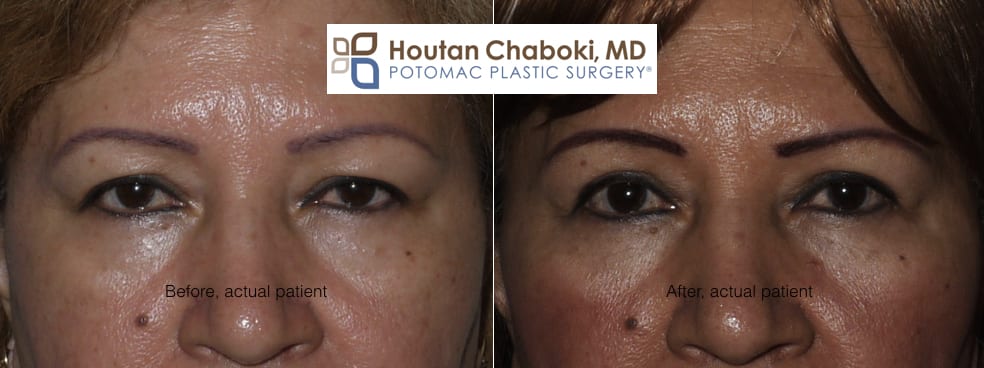
Before and 2.5 years after upper eyelid surgery (blepharoplasty). Natural, long term results with plastic surgery.
Despite the huge popularity of nonsurgical cosmetic treatments (ex. liquid facelift), surgery has not been replaced. Some facial areas still do better with surgery, especially for long-term results. Certain skin conditions, such as skin laxity or loose skin, are also better candidates for surgery.
The upper eye area is one region that patients choose surgery commonly. Excess skin develops in the upper eyelid and the eyebrow droops gradually with time. The combination of these changes crowds the eye. The eyes can appear smaller, which may give the impression of fatigue, disinterest, or worried appearance to bystanders. Women may also complain of difficulty with makeup, such as putting on eyeliner, mascara, and/or eye shadow due to the excess eyelid skin covering the eyelashes.
While Botox® and Dysport® injections can help open up the eyes and elevate the brow, these office injections provide temporary results. Patients, especially those with excess skin, may prefer natural, long term results with plastic surgery. Botox and Dysport can still be given after blepharoplasty to further smooth the forehead and crow’s feet areas.
Upper Eyelid Surgery and Recovery
One of the benefits of surgery of the upper eyelid is that it’s a relatively minor procedure with a brief initial recovery. Upper eyelid surgery (blepharoplasty) is one of the most common cosmetic surgery procedures performed via local anesthesia. The only discomfort patient have described during upper eyelid surgery is the initial numbing of the skin. The numbing medication works quickly and provides comfort during the entire procedure and afterward. Patients often do not taken prescription pain medication beyond the first day, if at all. Since upper eyelid surgery can be performed via local anesthesia, patients typically don’t experience nausea nor fatigue after eyelid surgery.
Upper Eyelid Surgery and a Facelift
Upper blepharoplasty may be performed alone. Plastic surgeons, however, may recommend additional cosmetic procedures, such as a brow lift, facelift, or fat transfer for total facial rejuvenation. Brow lift vs. upper eyelid surgery is a common area of confusion. The decision for plastic surgery is mutually determined by patient and surgeon based on many factors, including patient preference.
Share your thoughts below. Take the first step and contact the office to determine if you’re a possible candidate for upper eyelid surgery or other procedures to improve your appearance.

Leave a Reply